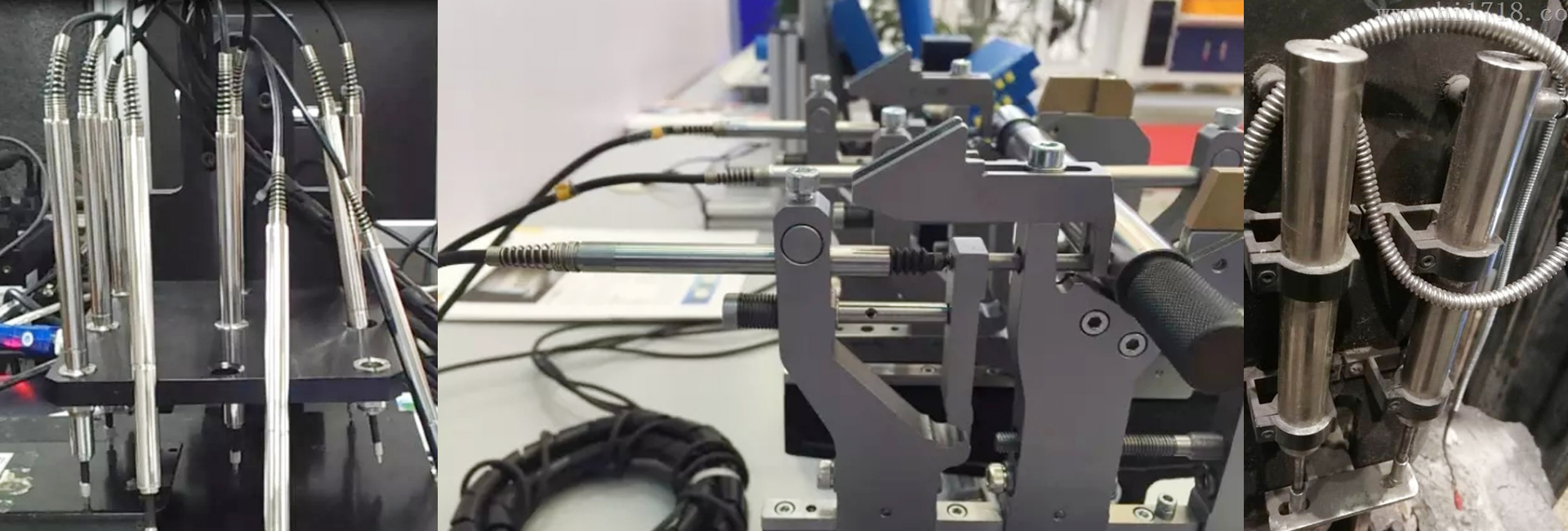How much do you know about LVDT linear displacement sensor?
How much do you know about LVDT linear displacement sensor?
Principle of LVDT Linear Displacement Sensor
LVDT (Linear Variable Differential Transformer), as a treasure in the field of precision measurement, stands out in many industrial applications with its excellent performance. Its core working principle is rooted in the profound principle of electromagnetic induction, which accurately captures the subtle changes of linear displacement or length in a non-contact way. LVDT is exquisitely constructed, which consists of a primary coil (the coil used as the excitation source), two secondary coils (the coils that sense and output signals) and a movable iron core (the core sensing component). When a steady alternating current is applied to the primary coil, it will build an alternating magnetic field in the surrounding space. With the precise movement of the movable iron core in this magnetic field, the voltages sensed in the two secondary coils will be different, and there is an accurate linear relationship between this difference and the displacement of the iron core. Based on this relationship, LVDT can accurately convert mechanical displacement into measurable electrical signals.
Precautions for Use
Power supply stability: the performance of LVDT is like a precise balance, which is extremely sensitive to changes in external conditions. Among them, the stability of power supply is one of the key factors affecting its measurement accuracy. In order to ensure the accuracy of the measurement results, it is necessary to ensure that the fluctuation of the power supply connected to the LVDT is within the allowable range specified by the manufacturer. Therefore, it is recommended to use a regulated power supply or a power filter to effectively reduce the adverse impact of power supply fluctuation on measurement accuracy.
Temperature management: Temperature change, like an invisible hand, quietly affects the internal structure and performance of the sensor. For LVDT, temperature change may lead to thermal expansion or cold contraction of its internal materials, which may lead to measurement errors. Therefore, when it is used in the environment with large temperature fluctuation, it is necessary to take appropriate temperature compensation measures or choose the LVDT model with temperature self-compensation function to ensure the stability of the measurement results.
Protection against vibration and impact: The internal structure of LVDT is precise and fragile, and its resistance to external vibration and impact is weak. Strong vibration and impact may lead to the damage or dislocation of the internal components of the sensor, thus reducing the measurement accuracy and even leading to the failure of the sensor. Therefore, in the process of installation and use, we should try to avoid exposing LVDT to vibration and impact sources, or take protective measures such as shock absorption and buffering to reduce its impact.
Regular calibration and maintenance: In order to maintain the high accuracy and long life of LVDT, regular calibration and maintenance are essential. Through regular calibration, measurement errors can be found and corrected in time to ensure the accuracy of measurement results; Daily maintenance can help to find potential problems and take corresponding measures to prevent them from getting worse. Therefore, users are advised to make detailed calibration and maintenance plans according to the manufacturer's suggestions and strictly implement them.
Installation Points
Accurate location selection: when installing LVDT, you need to choose a suitable installation location first. This position should ensure that the measured object can move freely without external interference, and it should also facilitate the connection and fixation of the sensor cable. When selecting the location, attention should also be paid to avoid exposing the sensor to harsh environments such as high temperature, high humidity and corrosive gases, so as not to affect its performance and service life.
Stable fixation: In order to ensure the stability of LVDT in the measurement process and prevent it from displacement or looseness due to vibration or impact, it is necessary to adopt a stable and reliable fixation method to fix it. Common fixing methods, including thread fixing and flange fixing, should be selected according to the actual situation. In the process of fixing, it is also necessary to keep the verticality and coaxiality of the sensor to ensure the accuracy of the measurement results.
Cable layout: the cable of LVDT is the bridge connecting it with external equipment, and its rationality and standardization directly affect the transmission quality of signals and the stability of the system.
Therefore, the following principles should be followed in the process of cable layout: firstly, the cable should be firmly connected without damage to avoid signal loss or interference; Secondly, the arrangement of cables should avoid excessive bending or pulling to prevent damage to internal wires or affect the quality of signal transmission; Finally, the direction of cables should be clear and orderly to facilitate subsequent maintenance and overhaul.
Shielding and grounding: In order to reduce the influence of electromagnetic interference on the measurement accuracy of LVDT, shielding measures should be taken for it and the signal line. This can be achieved by using shielded cables, wrapping a metal shielding layer outside the sensor, and so on. At the same time, in order to ensure the effectiveness of shielding effect, it is necessary to ground the sensor and signal line well to form a complete shielding system. In addition, attention should be paid to the size of grounding resistance and the selection of grounding mode in the grounding process to ensure the best grounding effect.
As a high-precision sensor, LVDT's performance stability and measurement accuracy depend not only on the quality of the sensor itself, but also on many external factors. Therefore, in the use of LVDT, in addition to the above precautions and installation points, it is necessary to conduct in-depth discussion and analysis from the following aspects:
Selection and matching: When selecting LVDT, it is necessary to comprehensively consider the range, accuracy, sensitivity and other indicators according to the actual needs to ensure that the selected sensor can meet the measurement requirements. At the same time, it is necessary to consider the matching with the measured object to ensure that the sensor can work stably and reliably and output accurate measurement results. Therefore, it is suggested that users should fully understand the characteristics and measurement requirements of the measured object in order to make a more reasonable choice.
Environmental adaptability: LVDT may be affected by various environmental factors such as temperature, humidity, corrosion, etc. These factors may adversely affect the performance of the sensor and even lead to sensor failure. Therefore, in order to ensure that the sensor can work stably for a long time, it is necessary to fully consider its environmental adaptability when selecting the sensor, and select the sensor model that can adapt to the actual working environment. At the same time, it is necessary to pay attention to the changes of environmental parameters and take corresponding measures to protect the sensor from environmental factors. Data processing and analysis: Of course, the output signal of LVDT needs to go through. We can further discuss other important aspects of LVDT linear displacement sensor, including its advantages, application fields and future development trends.
Advantages of LVDT Linear Displacement Sensor
High precision: LVDT is famous for its high precision, and it can measure tiny displacement changes, so it is very suitable for occasions requiring high precision measurement. High linearity: there is an excellent linear relationship between the output signal of LVDT and the measured displacement, which means that the measurement error can be kept at a low level in the whole range. High reliability: Because LVDT adopts non-contact measurement mode, it avoids mechanical wear and friction, so it has long service life and high reliability. Wide range: LVDT has a wide range, from small sensors to large sensors, which can meet the needs of different application scenarios.
Good dynamic response: LVDT can quickly respond to the displacement change of the measured object and output the measurement signal in real time, which is suitable for dynamic measurement and control system.
Application Area
LVDT linear displacement sensor is widely used in various fields because of its unique performance advantages: Industrial automation: In industrial automation production lines, LVDT is often used to measure the displacement, position and other parameters of mechanical parts to achieve accurate control and monitoring. Aerospace: In the aerospace field, LVDT is used to measure structural deformation, vibration and other parameters of aircraft such as airplanes and rockets, which is of great significance to the safety and stability of aircraft.
Energy and chemical industry: In the energy and chemical industry, LVDT can be used to measure the displacement and deformation of pipelines, valves and other equipment to ensure the normal operation and safety of the equipment.
Automobile manufacturing: In the automobile manufacturing industry, LVDT is used to measure the displacement and position change of automobile suspension system, braking system and other components to improve the performance and comfort of automobiles.
Scientific research and experiment: In the field of scientific research and experiment, LVDT, as a high-precision measuring tool, is widely used in mechanical properties testing of materials and structural vibration analysis.
Future Development Trend
With the continuous progress of science and technology and the rapid development of industry, LVDT linear displacement sensor is constantly innovating and improving. In the future, the development trend of LVDT may include the following aspects:
Intelligence: By combining with technologies such as Internet of Things, big data and artificial intelligence, LVDT will realize more intelligent measurement and monitoring functions and improve measurement efficiency and accuracy.
Integration: In order to meet the needs of different application scenarios, LVDT may be integrated with other sensors and actuators to form a more compact and efficient system solution.
High accuracy: With the continuous progress of manufacturing technology and the continuous innovation of materials, the measurement accuracy of LVDT is expected to be further improved to meet more stringent measurement requirements.
Environmental protection and sustainability: With the increasing awareness of environmental protection today, the design and manufacture of LVDT will also pay more attention to environmental protection and sustainability, and adopt more environmentally friendly materials and processes to reduce energy consumption and emissions.
To sum up, as a high-precision and high-reliability measuring tool, LVDT linear displacement sensor plays an important role in industrial automation, aerospace, energy and chemical industry. With the continuous progress of science and technology and the rapid development of industry, the future development prospect of LVDT will be broader.



